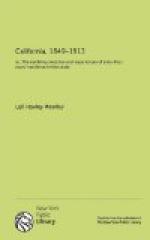On the north side of California street commencing at Powell was the residence of Mr. David Porter. This was torn down to make way for the Fairmont Hotel, ground for which was broken October 15, 1902. There were other small homes on other parts of the block but they too were removed and the entire block was used as a site for this famous hostelry.
In the early days a long shanty 40 feet by 10 to 12 feet in width stood where the Porter residence formerly stood. A man by the name of McIntire owned it. It was literally covered with California honeysuckle, and a view point of the town. This entire block was acquired by the late James G. Fair, one of the famous mining men of Nevada, and it still remains in the family estate. The hotel was in the course of construction at the time of the great fire of April 18-21, 1906, and the interior had to be rebuilt entirely as well as the stonework about the exterior openings.
The next of the large homes was that of James C. Flood, a handsome and imposing structure of Connecticut brownstone. This building stood upon the eastern half of the block between Mason and Taylor streets and in order to build, a huge hill of rock as high as the building now is, had to be removed. This was in 1876. After the fire of 1906 this building was remodeled and is now occupied by the Pacific-Union Club.
Mason street had just been cut through this same hill. On the west half of the block stood the home of the late D. D. Colton, who made his fortune out of construction contracts on the Central Pacific railroad. It was afterwards purchased by C. P. Huntington, another of the famous railroad magnates.
On the next corner stood the large frame mansion of Charles Crocker, one of the builders of the C. P. R. R., built at an expense of $2,500,000. His son William H. built himself a home on the far corner of the same block. This takes us to Jones street. When the late Charles Crocker selected this site for his home there was one piece of property facing on Sacramento street that he could not buy, so in order to get even with the owner, a Mr. Young, he had a tall spite fence built around the house. The owner lived there for a while, but being shut off as he was from the sunlight, had his house removed; still he would not sell and the fence stood there for years afterwards.
On the south side of the street commencing at Powell stood the mansion of Ex-Governor Leland Stanford. When Stanford purchased the property there stood there a fine house built by the actress Julia Dean Hayne, with an entrance at the corner. This house was removed to the corner of Pine and Hyde streets.
The stone retaining wall on Powell and Pine streets, owing to a spring on the property, gave way and had to be taken down (at the corner) and rebuilt. At the corner it extends 20 feet below the sidewalk and is 20 feet thick and 30 feet high. The ground was then terraced.
The building cost in the neighborhood of $2,000,000.




